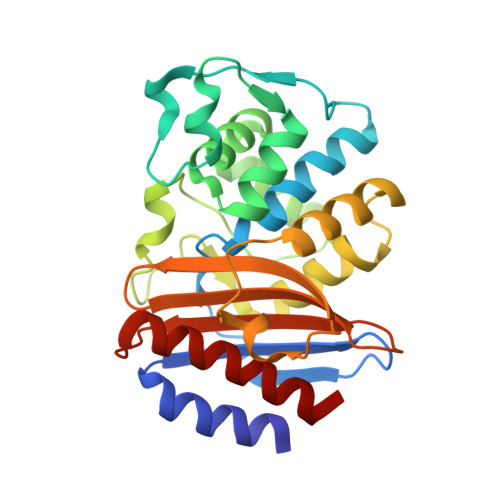Hyperstability and Substrate Promiscuity in Laboratory Resurrections of Precambrian Beta-Lactamases.
Risso, V.A., Gavira, J.A., Mejia-Carmona, D.F., Gaucher, E.A., Sanchez-Ruiz, J.M.(2013) J Am Chem Soc 135: 2899
- PubMed: 23394108
- DOI: https://doi.org/10.1021/ja311630a
- Primary Citation of Related Structures:
3ZDJ, 4B88 - PubMed Abstract:
We report a sequence reconstruction analysis targeting several Precambrian nodes in the evolution of class-A β-lactamases and the preparation and experimental characterization of their encoded proteins. Despite extensive sequence differences with the modern enzymes (~100 amino acid differences), the proteins resurrected in the laboratory properly fold into the canonical lactamase structure. The encoded proteins from 2-3 billion years (Gyr)-old β-lactamase sequences undergo cooperative two-state thermal denaturation and display very large denaturation temperature enhancements (~35 °C) relative to modern β-lactamases. They degrade different antibiotics in vitro with catalytic efficiencies comparable to that of an average modern enzyme. This enhanced substrate promiscuity is not accompanied by significant changes in the active-site region as seen in static X-ray structures, suggesting a plausible role for dynamics in the evolution of function in these proteins. Laboratory resurrections of 2-3 Gyr-old β-lactamases also endowed modern microorganisms with significant levels of resistance toward a variety of antibiotics, opening up the possibility of performing laboratory replays of the molecular tape of lactamase evolution. Overall, these results support the notions that Precambrian life was thermophilic and that proteins can evolve from substrate-promiscuous generalists into specialists during the course of natural evolution. They also highlight the biotechnological potential of laboratory resurrection of Precambrian proteins, as both high stability and enhanced promiscuity (likely contributors to high evolvability) are advantageous features in protein scaffolds for molecular design and laboratory evolution.
Organizational Affiliation:
Facultad de Ciencias, Departamento de Química Física, Universidad de Granada, 18071 Granada, Spain. [email protected]















